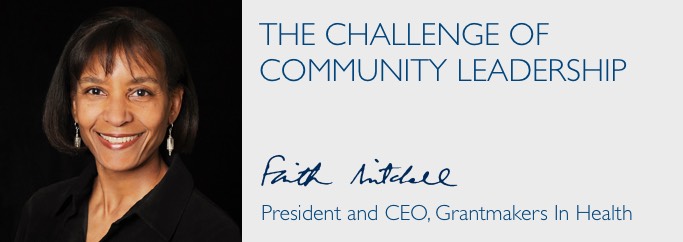
As we prepare for the 2018 annual conference, Navigating Currents of Change, I have been thinking about foundations and community leadership. The conference will provide multiple opportunities for trustees, CEOs, and program staff to dive into the complexities of this topic.
Leadership has many dimensions. It includes setting priorities, taking risks, and exercising a foundation’s voice to communicate its positions. Some health funders prefer to play a quiet role in their communities. They do not take public positions on local or national issues and are mainly responsive grantmakers. Others openly express their views on issues and their grantmaking is primarily driven by initiatives of their own design. Most funders fall somewhere between these poles.
There is growing evidence that organizations are more effective when they operate strategically by making choices, establishing priorities, and allocating resources to achieve a desired result. However, many funders appear to be hesitant to take this step. They worry that by not funding everyone who asks for support they are abandoning their responsibility to the community, or that they will generate hostility from the grantseekers who are declined. For funders who are the only source of philanthropic dollars in their area, this pressure can be especially intense. But a funder who is everyone’s friend is not a leader. Leadership requires making difficult decisions about the community issues that are first in line for attention.
In family foundations, the founder’s vision can fuel a commitment to leadership. This was my experience working at the Hewlett Foundation, where our grantmaking areas and priorities were shaped by board chair William Hewlett’s sense of the important issues of the day and by his goal that the foundation would play a decisive role with respect to those issues. Leadership becomes more difficult when a foundation is the result of an organizational transaction, as many health foundations are. This can be especially true in the foundation’s early years. For example, conversion foundations often face the challenge of converting general guidance about “protecting the assets that have been permanently dedicated for public benefit purposes” into a sense of mission. Where to begin? The foundation’s board may be made up of former hospital board members, community volunteers, or political appointees who are new to philanthropy. Board members may not have strong mutual ties other than a shared interest in serving the community.
These factors make being on these types of boards—not to mention being the board chair or foundation CEO—a challenging enterprise. Given what it takes to blend the different perspectives and priorities of diverse people into a coherent vision for the foundation, exercising community leadership can be quite difficult. But these challenges can be overcome, as we have seen among GIH’s Funding Partners. When they are, the rewards include ongoing relevance to the primary issues facing communities, the vitality that results from taking a variety of views into account, and the organizational confidence that is fundamental to being an effective community leader.
What shape does leadership take at your foundation or corporate giving program? Join us in Chicago this June and share your story!

